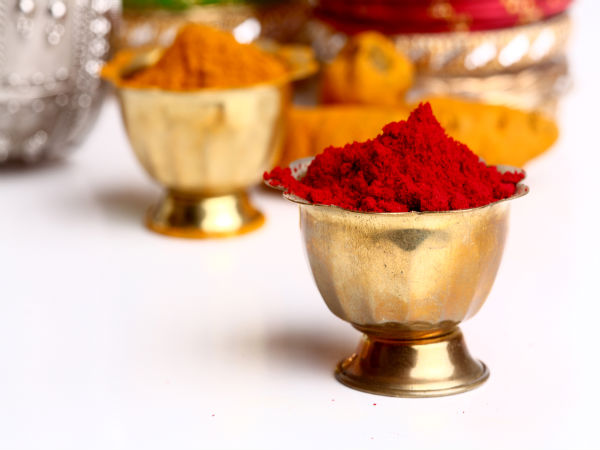In any Hindu rituals, the event is not complete without the use of vermillion and turmeric. Know why these materials are so significant in the Hindu religion.
From an ancient time, kumkum or vermillion and turmeric are regarded as two of the holiest materials in the Hindu religion. From a marriage to any puja, these two ingredients are used at any given auspicious time and day. Let us know what is the significance of kumkum and turmeric in the Hindu religion. Kumkum or sindoor is an ingredient that is inseparable from the Hindu married women. Married women put a bindi of kumkum on their forehead from ancient time and to make kumkum, turmeric and natural camphor are the primary ingredients.
When it comes to turmeric, this is another auspicious item which is required in any religious ritual in Hinduism. Even turmeric is used for making the idols of Lord Ganesha for the Ganesh Pujan. The significance of turmeric are many, as it is also beneficial for health. Being a natural antiseptic, it can be used to heal cuts and burns and also any internal health problems. To know more about the significance of kumkum and turmeric, keep reading.
1. Kumkum Symbol of Hindu Married Women: From an ancient time, Hindu married women put vermillion on their forehead as a bindi and at the front of their middle-parted hair as tilak. Putting sindoor means they desire for the longevity and success of their husband.
2. Turmeric Stands for Purification: You must have seen in Hindu marriages that there is always a ‘Haldi’ custom. Here, the paste of turmeric is applied to the bride. It stands for purifying the bride from all sins and prepares her for the auspicious ceremonies of the wedding ceremony.
3. Kumkum Symbol of Female Energy: According to scholars, red is the colour of power and energy, and it stands for the power of Goddess Parvati or Sati who is the epitome of energy. According to the Hindu mythologies, Sati is the ideal wife as she dedicated her life for her husband. Every woman should follow her and hence, apply kumkum to show her devotion to her husband.
4. Turmeric Symbol of Many Things: According to popular belief, turmeric is the symbol of the sun, good luck and fertility. It also symbolizes the inner pride of a human being and also the overall prosperity. That’s why, in every pious occasion, turmeric has been used always.
5. Astrological Significance of Kumkum: According to the Hindu astrological belief, kumkum is also the symbol of Saubhagya or good luck. Actually, it is believed that the forehead is the place of the Mesha Rashi and Mars is the Lord of Mesha (Aries) Rashi. As it brings good luck to life, married women apply kumkum on the forehead.
6. The Colour Significance of Turmeric: Turmeric is available in orange and yellow forms. You will be surprised to know that these colours also have their specific meaning. While yellow stands for chastity and sensuality, orange is the colour of the sun, courage and sacrifice.
7. Mythical Significance of Kumkum: Kumkum is made of turmeric and lead. From an ancient time, it has been believed that kumkum boosts up sexual drive. That’s why married women apply kumkum, and it is prohibited for unmarried or widow women.
8. Significance of Turmeric on Your Health: Using turmeric in warm milk can keep you relaxed. Not only that, but turmeric milk also heals any acid reflux or other pain in your body. Applying turmeric on your skin can bring a nice glow to your skin.






